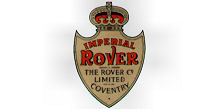




ALTHOUGH at first sight there does not appear to be any great change in the latest Rover models, yet, on examination, it will be found that the new machine has been redesigned from end to end. Starting with the engine, we find that the valve ports have been enlarged and improved, and the new valves have an extremely large port area. The timing gear also has been slightly altered, although it is on the same lines as before. Even the piston and connecting rod have been altered to a slight degree with results beneficial to the running of the engine. The driving side of the crankshaft is mounted on two separate ball bearings, so as to give ample surface to take the pull of the driving chain.
A silent chain conveys the drive from the crankshaft to a three-speed countershaft gear; this chain is entirely enclosed in the die cast aluminium case. The three-speed gear box is of very neat construction, land has only sliding members, consisting of two rods and one gear wheel.
The clutch is the cork insert type, and the kick-starter is neatly enclosed in an extension of the gear box. One of the most unusual features of the box is that the lid is formed by the bottom bracket framework, which gives a very neat appearance to the device and saves a certain amount of space. The final drive is through an 8in. pulley and a 1 in. belt, the gear ratios being approximately 5 to 1, 7½ to 1, and 15 to 1, the lower gear being, of course, purely an emergency one. The gearshafts are mounted on ball bearings throughout.
Frame and Fittings.
The frame alterations are not very noticeable, but besides the new bottom bracket lug, the steering head has been given an increased rake. 650 x 65 tyres will in future be fitted on all models, and excellent mudguards, which are fully valanced on both sides, protect the rider in bad weather. A belt guard is also standard, and the front portion of the rear guard is extended below the level of the lower part of the belt, so that mud cannot pour over it and cause slip.
The handle-bars are somewhat wider than in previous years, and are bent into a very comfortable position. The standard lubrication will be by plain pump fitted with a tap at the bottom, or Best and Lloyd's automatic drip feed can be obtained to order. The hinged carrier and guards and the powerful double lever in front of the brake will remain as in the 1914 model. A Lucas dynamo lighting set can be fitted as an extra, and, if supplied, it is fitted behind the saddle tube and driven by an enclosed chain from an extension of the countershaft. Sidecar chassis and body are modified in detail only, and the neat spring luggage carrier is still retained on the back of the chassis.
The feature of this outfit is the compensated sidecar brake, actuated by the usual foot pedal on the motor cycle. A very neat fitting has been devised for ensuring that the back wheel shall be in line. This consists of a form of notched quadrant, carried on the spindle, the notches engaging with a projecting boss. It is only necessary to engage the same notch on each side of the wheel with the boss to make sure that the wheel is in proper alignment. A similar engine to that already described, but with slightly higher compression, is fitted to the T.T. model, which is turned out as a standard with a single belt drive, though a Philipson governor pulley may be obtained as an extra. If fitted, this pulley is, of course, handle-bar controlled.
The handle-bars are almost straight and give a comfortable racing position. The wheel base of the new T.T. model will be longer than before, and is, in fact, the same as in the standard model; 650x65 tyres are fitted. Both models are fed by 1915 B. and B. carburetters with a top feed to the float chamber. A very neat refinement is in connection with the petrol tank; the gauze filter carries with it a bright metal float, which is usually visible through the glass top, and gives the rider an approximate idea of the amount of petrol remaining in the tank at a glance. Also at night the top of the float can be felt by the finger.
The Motor Cycle, November 19th, 1914 p565.
THE General Post Office is one of the largest users of sidecarriers, and we illustrate one of the latest 3½ h.p. three-speed Rovers supplied for carrying parcels and mails. Two of the particular features calling for notice in this outfit are the suspension of the load on the cradle chassis, and the well-known sidecar brake. There is no doubt that being able to brake both rear wheels on vehicles of this description is an important point, especially in a hilly country where heavy loads are being carried.
The springing of the load is admirably carried out by means of long side springs shackled at the rear, the result being that the body rides without perceptible movement, either empty or when fully loaded. The importance of this will easily be realised when it is remembered that such a vehicle would be largely used for the delivery of small parcels frequently containing fragile material, and in many cases over the rough and stony roads and lanes of inaccessible rural districts.
The Motor Cycle, September 10th, 1914.